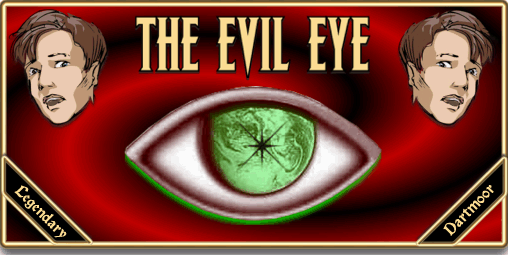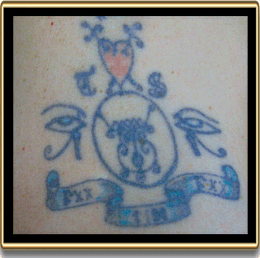
Anybody who watches ‘Little Britain’ will be converse with Vicky Pollard’s well know saying – “don’t give me evos!” which loosely translated is modern parlance for, “don’t give me the evil eye!”. Nothing new here then in fact there is nothing new with the ‘evil eye’ as its tradition goes back centuries, maybe even millennia. On Dartmoor it was/is a real belief that certain people had the ability to cast an evil spell just by fixing a malevolent stare on someone or if you like giving them the evil eye. There are several legends of old Dartmoor women such as Martha Witchalse who had this art down to perfection. The effects of the evil eye were various but at their most lethal, as Crossing (1997, p.96) describes:
“Speedily would the power be felt. The poor victim would fall ill, and be unable to take food. Sleep was denied him; and he would be racked with constant pains. He knew, and his neighbours knew, that he was ill-wished, and that he would never recover unless a counter charm could be discovered.“
It was normally the ‘wise woman’ or ‘hedgerow witch’ that provided the counter charm. If her spell worked then her fame grew but if it didn’t then the evil reputation of the ‘ill wisher’ was greatly enhanced. It was not only humans that were victims of the evil eye as there were many cases of animals suffering injury or death from the dark powers of ill wishing. The annals of folklore states that it is the first direct glance from the person giving the evil eye that has the ‘sting’. From this stems all the ensuing evil and so if it can be diverted then the black spell would never work. It was in this light that many moor folk would wear brightly coloured buttonholes in the belief that the evil doer’s first glance would be drawn to such an item, thus rendering the spell harmless. Certain plants such as dill, vervain, mountain-ash, elder and St. John’s Wort were thought to be efficacious in this matter. Often glass ‘witch-balls’ would be hung in cottage windows, also in the hope that they would attract the ‘first glance’. The same theory was applied to garlands of flowers and bunches of berries that were hung in the barns and shippens of the farms only these were to protect the animals, Ledger Gordon (1973, p.156).
Should all these deterrents fail then as mentioned above the next port of call was the ‘hedgerow witch’ who hopefully would cast a spell to counteract the powers of the black witch. One such a spell was to get three tight-necked jars and place into each of them a frog’s liver stuck full of new pins and a toad’s heart stuck full of thorns from the holy bush. The jars would then be corked, sealed and buried seven inches down in three different churchyard paths. As the jars are being buried the Lord’s Prayer must be repeated backwards, then as the livers and hearts decay so does the power of the black witch. According to Hewitt, (1976, p.64) the surest way to escape from the forces of the evil eye was to draw blood from the body of the ill-wisher. She records an example of an old man who confessed that he had, “raped old mother Tapp’s arm with a gert rusty nail two or three times, “till he made the blood flow freely. “She can’t hurt me again arter that,” he said.“
The evil eye is by no means exclusive to Dartmoor and the belief can be found amongst most cultures around the world, many of them dating back to prehistoric times. I would also tactfully suggest that the tradition with some people is a strong today as it has always been No prizes for guessing who came back from Crete with a string of beads that were guaranteed to protect against the evil eye and who to this day still carries them in his pocket. If you have ever been to these Mediterranean countries and seen the men playing with their ‘worry’ beads all day you will know what I mean, I think it looks cool. Oh, and whilst you are guessing, who has the ‘Eye of Horus’ tattooed on his right arm? In my defence, many years ago I asked a ‘woman who knows things’ to come up with an amulet which she accordingly did. I then thought it would be a great idea to have it tattooed on my arm, pretty straightforward one would think. I nipped into town and went into a stationary shop to get the original amulet photocopied. The piece of paper was handed over to the assistant who took one look at it screamed, threw it and me out of the shop whilst yelling something about “evil. heathen rubbish.” It was on my way out that I noticed a fish symbol on the door. But luckily the local estate agents had no such worries and so the amulet was photocopied and then tattooed on my arm. The ‘woman who knows’ told me that the Eye of Horus gives protection against the evil eye – not that I believe in such rubbish. Just in case you don’t believe a word of this the now fading tattoo is depicted below:

Sadly I never did find out what the other symbols were all about, the ‘woman who knows’ died shortly afterwards from some mysterious malady. The only thing I remember she did say was to, “never let anyone touch the actual amulet, especially a woman?”
Bibliography.
Crossing, W. 1997 Folklore and Legends of Dartmoor, Forest Publishing, Liverton.
Hewitt, S. 1976 Mummits and Crummits, EP Pub., Wakefield.
Ledger Gordon, R. 1976 The Witchcraft and Folklore of Dartmoor, EP Pub., Wakefield.
 Legendary Dartmoor The many aspects past and present of Dartmoor
Legendary Dartmoor The many aspects past and present of Dartmoor
